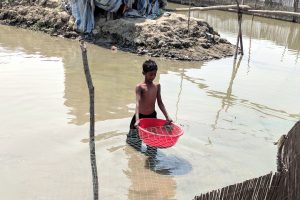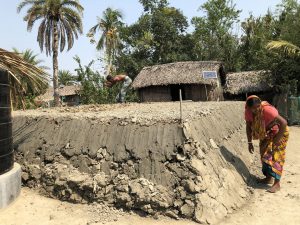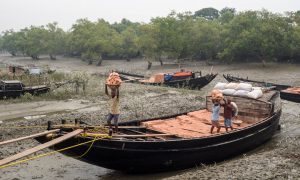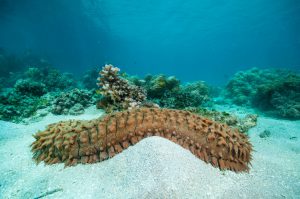Ladakh accounts for more than two-thirds of the land area of the Indian state of Jammu & Kashmir. As a high altitude cold desert, though, it hosts only about 5% of the state’s population. It does, though, host a large number of Indian Army personnel, as Ladakh is where two of the longest unresolved border disputes in the world – between India and China to the east, and between India and Pakistan to the west – are still ongoing. As a result the Indian Army has to transport a very large amount of fuel to keep its soldiers warm in the harsh, high altitude climate.
With the mercury dipping to minus 20 degrees Celsius or lower during winter nights, and about minus 5 degrees Celsius at night during March and April, it becomes virtually impossible to live without proper heating.
To top it, Ladakh is not connected to the national electricity grid. It has a few areas that get power from local hydropower plants while de-centralised solar power helps in many other remote areas but is highly inadequate.
With extreme climatic conditions and remote habitations, Ladakh faces massive problems transporting diesel, kerosene and even firewood from long distances. It not just involves cost but also becomes a major contributing factor to air pollution in the fragile Himalayan ecology.
Could passive solar housing change all that?
This may be due to change, as the Indian Army has been looking at local experiments in passive solar housing. This form of design takes advantage of a building’s location and climate with use of materials such as earth and local resources that will lead to low or negligible use of energy for heating throughout the day
Sonam Wangchuk, an innovator-entrepreneur from Ladakh, has developed this housing concept. Wangchuk has won the prestigious Global Award for Sustainable Architecture 2017 that recognises the work on “passive solar heated Earth buildings and the Ice Stupa project on sustainable architecture.”

The school buildings are heated without using any of the conventional energy sources burning carbon dioxide. But the heating is so good that the temperature in the interiors of the main building at Phey village (near Leh) remains comfortable even in peak winter without electric-powered heating or firewood burning.
Earth and sun architecture
Showcasing the earth and sun architecture, as it is called, Konchok Norgay, the teacher in-charge at the SECMOL School, listed the most important feature of the concept — the south face of a building needs to be all windows, as it gets maximum sunrise to sunset exposure in winters.
The SECMOL School’s main building’s south side has a huge thick plastic sheet attached to these windows at an angle. This stops strong chilly winds but allows sunlight and heat in winters. This sheet is rolled up in summer to let in fresh air and to avoid overheating.
The top of the building has glass openings to keep the insides of the building well illuminated during the day and also trap heat in winters. Essentially, it is the double-layered, south-facing windows (plastic sheet and glass or both glass) of the main building and also that of the students’ hostel.

“The idea of passive solar design is that it absorbs and traps all the heat directly from sunlight and the architecture lets us store it for long,” he said. “Even without using any energy-demanding artificial heating methods, we have been staying and running the school here every winter for more than a decade now.”
The Indian army had invited Sonam Wangchuk to its seminars on warm habitats in cold places like Ladakh. Two winters ago, Wangchuk and his team had even built a prototype of a cost-effective solar-heated mud-built house for officers, and the army has been testing it.
“The Indian Army spends a lot of money and carbon for keeping soldiers warm in a cold place like Ladakh whereas Ladakh is one of the sunniest places,” Wangchuk told thethirdpole.net. He emphasised that this was one way to stop spending the national treasure for buying foreign oil. “You can be independent in every way using the sun. The model has been proved.”
Echoing what Wangchuk had to say, army officers said the troops had got one shelter constructed at Manla Complex in Skanzangling, near Leh, based on passive solar-heating using local techniques. “As per the feedback received (from Ladakh), the concept and design is successful,” an army officer told thethirdpole.net. “Although in the current financial year (ending March 31), there was no such project considered for execution, the concept will be considered in future in 14 Corps. However, quantum of habitat planned is not decided yet.”
According to a September 2017 report, the Indian Army was looking for a “durable power supply in high altitudes to enhance the living conditions of its personnel” wherein solar and wind energy, in abundance at high altitudes, are also under consideration. “Solar power projects are few in number and are unable to meet the peak power demand for 21 military stations in winter,” the report had said.
Livelihood for housing entrepreneurs
The idea that the relatively low-cost housing pattern can be of use in the long term has found many takers. In view of the demand in future, the SECMOL team, led by Wangchuk, has already been organising short-term courses every summer (Ladakh’s summer is in July and August) on solar design, earth buildings and ecological toilets. In 2017, it organised a festival enabling participants to “learn the essentials of mud and solar construction and celebrate the Sun and Earth”.
It is SECMOL’s way of gearing up to launch young entrepreneurs who can fulfil the Indian Army’s demands through which youngsters would build careers in the mountains and the army will get cleaner habitats with lower costs and carbon footprints. “It will be safer too, because many soldiers are burnt in fire accidents because of kerosene,” Wangchuk told thethirdpole.net.
An earlier version of this article was published on indiaclimatedialogue.
![<p>South-facing glass windows combined with a plastic sheet keeps interiors well illuminated and warm [image by: Nivedita Khandekar]</p>](https://dialogue.earth/content/uploads/2018/03/Ladakh_Story_2.jpg)







